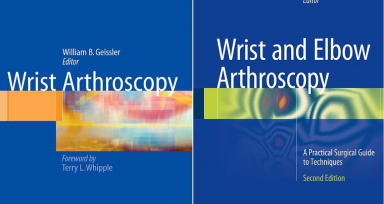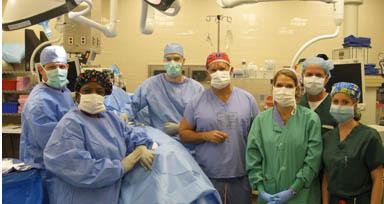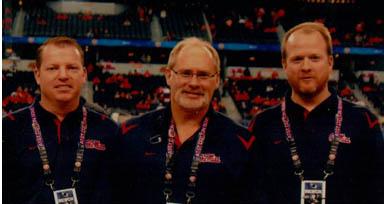Click a link below to read more information about the procedure.
- Elbow Replacement
- Elbow Arthroplasty
- Elbow Arthritis in Younger Patients
- Elbow Fractures
- Distal Humerus Fractures
- Olecranon Fracture Plating
- Coronoid Fractures
- Loose Body Removal
- Lateral Epicondylitis Release
- Synovectomy
- Joint Contracture
- Radial Head Excision
- Distal Biceps Tendon Repair
- Elbow Arthroscopy
Replacement of the elbow joint is relatively rare. Indications for elbow joint replacement include severe bone deformity secondary to rheumatoid arthritis, osteoarthritis, post-traumatic arthritis, and fractures in the elderly. Bone deformity from rheumatoid arthritis is the most common indication for elbow replacement. Patients with a severe bone deformity of the elbow frequently present with severe pain, lack of motion, and potential angulation of the joint. In older patients, total elbow replacement may significantly improve range of motion, pain, and angulation.
The typical procedure involves an incision on the posterior or back of the elbow. The ulnar nerve is carefully identified and protected, and retracted. The muscles are elevated to expose the bone, and then the bone cuts are made for the prosthesis. The prosthesis fits down the medullary canal on both the humerus and ulna. The radial head may or may not be replaced during the procedure. Replacing the radial head can potentially take some of the stress off of the elbow component.
When one talks of total elbow replacement, the elbow may be linked or unlinked. In a linked prosthesis, both the humeral and ulna components are linked together. There is usually some play between the components of approximately 5-10 degrees. This play between the components helps take the stress off the components in relation to the bone, and potentially can decrease loosening in the future. In patients who have severe bone deformity, ligament instability, or fractures usually a linked prosthesis is utilized. This would decrease the chance of any dislocation to the prosthesis.
In patients with posttraumatic deformity, good bone stock and ligaments, an unlinked prosthesis may be selected. In this manner, there is less stress to the prosthesis itself, and theoretically less risk of loosening in the future. Following replacement of the elbow joint, ligaments may be reattached so the stability of the elbow implant is based on the patient’s own ligaments and not to the prosthesis itself. While this may decrease the risk of loosening to the prosthesis, theoretically there would be a low risk of dislocation of the prosthesis. Frequently, the decision to link or unlink a prosthesis can be made inter-operatively at the discretion of the surgeon.
Patients with bad deformities of the elbow usually have some involvement of the ulnar nerve. Involvement of the ulnar nerve can result in weakness of the hand muscles or decreased sensation to the small and ring fingers. Following elbow replacement, the ulnar nerve is usually transposed anteriorly to help with these symptoms. Patients are then put in a splint with the elbow in near extension for a week to two weeks to protect the skin on the posterior aspect of the elbow. The splint is then removed, and active and passive range of motion is initiated. Most patients notice significant improvement in pain, range of motion, and strength by three months postoperatively.
Particularly, in elderly patients with a severe comminuted intraarticular fracture of the elbow, a total elbow replacement bypasses the fracture. Patients are started on initial range of motion approximately two weeks following the surgery. It has been shown in several studies that in elderly patients with a severe intraarticular fracture that total elbow replacement results in improved range of motion and pain relief as compared to internal fixation. With internal fixation particularly in soft bone, the patient is protected for range of motion and it may take a prolonged time for the fracture to heal and potential risk of implants from cutting out of the bone. Replacing the elbow joint with an artificial elbow bypasses the potential risks in certain elderly patients with a extensive comminuted fracture in soft osteopenic bone and decreases this particular complication as compared to open reduction and internal fixation.
Patients who develop bone spurs or osteophytes about the elbow notice decreased range of motion of the elbow with terminal flexion and extension. Patients experience pain with terminal flexion and extension in this condition. This generally occurs in middle aged males and particularly with a history of heavy use to the elbow. In patients who have pain at terminal flexion and extension but not during the mid range, particularly are very minimal to arthroscopic excision of the osteophytes.
In this procedure, the osteophytes off the front of the elbow are excised through two portals in the medial and lateral aspects of the elbow. The anterior capsule may be released to help further improve elbow extension. Two portals are then made in the posterior aspect of the elbow, and any bone spurs are removed off the back of the elbow including the olecranon fossa. This can also improve patient’s extension and flexion. In some patients, an ulnar humeral arthroplasty is performed. In this manner, the olecranon fossa is opened to allow communication between the anterior and posterior aspects of the elbow. This can further help provide pain relief with terminal flexion and extension of the elbow.
The procedure is performed on an out patient basis and generally takes 60‑90 minutes to perform. Patients start immediate range of motion following the procedure and notice improvement in 6‑12 weeks.
Elbow Arthritis in Younger Patients
Arthritis to the elbow is a relatively rare problem. Usually when it occurs in a younger patient, it is from a previews history of trauma. Total elbow arthroplasty is an excellent solution to arthritis of the elbow, but is generally selected in older patients who are lower demand. The individuals’ limitations of total elbow arthroplasty is generally the patient limits lifting to less than ten pounds. Concern is that the elbow prosthesis may loosen over time if too much stress is applied to the elbow.
The question is what to do with a younger patient who develops traumatic arthritis to the elbow.
A potential option is fascial arthroplasty to the elbow joint. In this procedure, the elbow joint itself is covered with fascial implants that cover both the olecranon and the distal humerus. The goal of this procedure is to obtain pain relief, a functional range of motion, and buy time until the patient may require an elbow replacement in the future. The concern of the procedure in the past has been elbow instability post operatively. With newer technology, including the internal brace fibertape, allows the procedure to be performed while maintaining immediate stability to the elbow. This allows for an early range of motion physical therapy program.
Fractures of the elbow are relatively common as the elbow is rather superficial and not covered with significant muscle mass. Falls directly on the elbow are common mechanisms of injury. Fractures of the elbow may be classified as supracondylar (those fractures involving the distal humerus), fractures of the radial head (which involve the proximal radius), and fractures of the olecranon (fractures of the proximal ulna). Because these fractures can involve the joint surface, frequently they will need to be stabilized and anatomically reduced to achieve the best result and limit posttraumatic arthritis in the future. Previously, implants designed for the elbow were considered bulky and potentially had to be removed in the future. Dr. Geissler worked with an international team of orthopaedic surgeons and engineers from Medartis to design a system of low profile variable angle locked plates for management of fractures of the elbow. For fractures of the radial head, the implant is very low profile yet provides very stable internal fixation resulting in potentially less chance of metal removal after the fracture has healed. For fractures of the olecranon, the plates are actually placed on the side of the elbow rather than straight posteriorly so the implant is not felt as the patient puts his arm down on a desk or chair. This significantly decreases the incidence of metal removal for fractures of the olecranon. For supracondylar fractures, a system of plates was designed to stabilize the fracture with multiple new technical advances.
Intra articular fractures of the distal humerus are very difficult to manage. Typically, they involve relatively small bone fragments at the level of the joint, which are hard to stabilize. Dr. Geissler worked with an international team of upper extremity orthopedic surgeon specialist and engineers from Medartis to develop a new unique set of implants to stabilize fractures of the distal humerus. These implants allow the unique combination of parallel fixation distally, which biomechanically has been shown to be the strongest. And, as one goes more proximally, the plates curve on the posterior aspect of the humerus to make screw insertion easier for the surgeon. It is thought this unique design of implants will help simplify the stabilization of this very complex fracture.
Fractures of the olecranon occur at the proximal aspect of the ulna at the level of the elbow joint. Usually these fractures are intra-articular or involve the joint surface. The majority of these fractures need to be stabilized with open reduction and internal fixation if they are displaced because it involves the joint surface. These fractures may be stabilized by pins and wires, plates, or potentially intramedullary fixation.
Implants placed on the dorsal aspect of the elbow (wires and pins), are frequently symptomatic to the patient because there is only skin coverage of the metal implant. A lot of these implants have to be removed because of the irritation and pain to the patient. Dr. Geissler co-designed, with other surgeons and the engineers from Medartis, plates that were designed to be placed on the side of the olecranon rather than straight dorsally. In this manner, the plates are much less symptomatic compared to traditional dorsal plates and have a much lower metal removal rate. In addition, by placing a plate on each side of the olecranon, frequently allows for more screws to be placed in the proximal fragment allowing for greater stability to the fracture.
Text coming soon
Text coming soon
The indications for elbow arthroscopy continue to grow as new instrumentation is being developed. There are several indications for elbow arthroscopy including loose body removal, synovectomy for rheumatoid arthritis, tennis elbow release, elbow contracture release, and removal of bone spurs secondary to osteoarthritis to improve the patients range of motion and pain.
Loose body removal is probably the most common indication for elbow arthroscopy. Patients complain of locking or catching sensations to the elbow. There has usually been a history of trauma to the elbow in the past. Radiographs frequently show a bone fragment floating in the joint. Loose body removal is very minimal to be performed arthroscopically.
The procedure is performed on an out patient basis. Both the anterior and posterior compartments of the elbow are evaluated usually through four poke holes the size of a pencil. Any loose body seen in the anterior compartment is removed as well as the posterior compartment. The patient will wear a dressing for three days. Range of motion and strengthening are initiated as the patient can tolerate and there are no restrictions.
Tennis elbow is a very common orthopaedic condition in the community. Patients complain of pain about the lateral side of the arm with grip. They frequently complain of pain while lifting a milk jug or with gripping. Some patients remember a specific incident that initiated the pain about the lateral side of the elbow. Fortunately, most of the cases of tennis elbow resolve through non-operative management. Occasionally, patients continue to complain of persistent pain about the lateral side of the elbow.
In these patients, either arthroscopic or open release of the lateral epicondylitis may be performed. Arthroscopically, two poke holes are made, one on the inside and outside aspect of the elbow. The capsule about the lateral side of the elbow and the tendon may be arthroscopically released from its insertion onto the lateral epicondyle. The tendon most frequently involved is the extensor carpi radialis brevis tendon. This procedure is performed on an out patient basis and takes approximately 30‑45 minutes to perform. Patients keep the dressing on for three days and then start a range of motion strengthening program. Both arthroscopic and open release of lateral epicondylitis has good results in the literature. Some studies show that arthroscopic release has potentially faster return to work and activities.
Patients with rheumatoid arthritis frequently have involvement of the elbow joint. Rheumatoid arthritis and abutment synovitis occurs in the elbow joint causing potentially joint effusions, pain, and limitation of motion. Particularly, when there is not advanced bone destruction, this is very minimal arthroscopic debridement. Four poke holes are made about the elbow. Through these portals, the excessive synovitis may be arthroscopically débrided and removed. This helps de-bulk the elbow joint, improving pain, range of motion, and decreases the amount of joint swelling. This is performed on an out patient basis and takes approximately one hour to perform. Patients wear a dressing for three days and start immediate range of motion exercises.
The functional range of motion of the elbow is -30 degrees of extension to 130 degrees of flexion. Patients are able to do the majority of the tasks of daily living with that range of motion. When motion decreases beyond that, patients frequently notice limitations to their upper extremity. The purpose of the elbow is to position the hand in space and when a significant contracture occurs to the elbow it decreases function to the upper extremity. Contracture of the anterior capsule of the elbow which results in decreased elbow extension is very amenable to arthroscopic release. In this manner, the capsule can be released off its insertion onto the humerus through a portal made on the medial and lateral side of the elbow. A decrease in elbow extension also can be secondary to bone spurs or osteophytes in the posterior compartment of the elbow. Through an additional two portals, these osteophytes and fibrous tissue about the olecranon may be removed to further improve the patient’s extension. This procedure is performed on an out patient basis and usually takes approximately one hour to perform.
A dressing is worn for three days and patients start immediate range of motion and strengthening. There are no restrictions. Patients note significant improvement in their range of motion 3‑6 weeks from surgery.
Arthritis of the radiocapitellar joint is fairly uncommon. However, patients who may have had a previous intraarticular fracture of the radial head may have a traumatic osteoarthritis involving the radiocapitellar joint. Also, in patients with rheumatoid arthritis, frequently have involvement of the radiocapitellar joint causing pain. In patients with radiocapitellar arthritis, particularly complain of pain with pronation and supination of the forearm. When the arthritis is particularly limited to the radiocapitellar joint, the radial head may be excised to help improve the patient’s pain with pronation and supination of the forearm. This is performed arthroscopically or through an open incision.
In the arthroscopic procedure, the radiocapitellar joint is evaluated through two portals on the medial and lateral side of the elbow. An additional portal is made behind the elbow. In this manner, the radial head may be arthroscopically excised which is normally in contact of the radial head through the capitellum.
The procedure takes approximately 30‑45 minutes to perform. Patients start immediate range of motion. The procedure is performed on an out patient basis.






